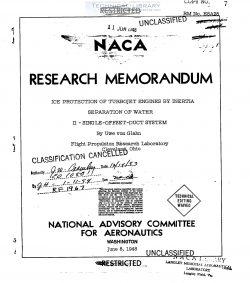naca-rm-e8a28
- Version
- 96 Downloads
- 493.07 KB File Size
- 1 File Count
- April 21, 2017 Create Date
- April 21, 2017 Last Updated
National Advisory Committee for Aeronautics, Research Memorandum - Ice Protection of Turbojet Engines by Inertia Separation of Water - II - Single Offset Duct System

The results of an aerodynamic and icing investigation of a
single-offset-dnct system. that was designed to prevent the entrance
of water and foreign. particles into a turboJet engine are presented.
The results show that the single-duct inlet incorporating internal
water-inertia separation features had a. 2 percent better ram-
pressure recovery than that for the alternate duct used in the two-
ccnce'ntric-duct system. The single-duct ram-pressure recovery of
77 percent, however, was considerably less than the recovery
attained with the main duct of the two-concentric-duct system. Good
ice protection was attained with the configuration investigted.
The design of a single-duct inlet of the internal water-
inertia separation design has several advantages over the two-
ccncentric—duct system described in reference 1 provided that a
high ram-pressure recovery can be attained. The single-offset-duct
design eliminates the rapid diffusion at the alternate-duct inlet
and outlet, which are inherent in the main duct of the concentric-
duct system. The single-cffset-duct system also is independent of
the main-duct-smen icing characteristics during an icing condi-
tion. Furthermore, small dust particles and even pebbles can be
effectively prevented from entering the engine by proper design of
the inlet. For fabrication and installation, the single offset
duct is lighter and has more space available for accessories than
the two-concentric-duct system. The accessory-housing nose can be
more easily and better armored than direct-ram or concentric-duct-
inlet systems, thereby providing more protection for the engine.
The unheated icing tolerance, which is relatively great for the
two-duct system, is considerably reduced for the single-duct system
because of the elin‘zination of the main duct that serves as an ice
trap for a large amount of water entering through the nacelle inlet.
A greater surface area must be heated continuously and provided with
water drains in order to have the system operate effectively.
| File | Action |
|---|---|
| naca-rm-e8a28 Ice Protection of Turbojet Engines by Inertia Separation of Water - II - Single Offset Duct System.pdf | Download |

Comment On This Post